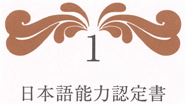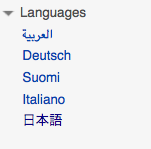When you are translating something, sometimes there are words or phrases that just aren’t in the dictionary. A site like ALC is amazing for Japanese/English translations, but even ALC doesn’t have everything.
In those cases, I have found Wikipedia to be an excellent online resource for doing translations. Although a word or phrase might not be in the dictionary, there might be a Wikipedia article about it. And if there is a Wikipedia article in one language, it might have a translated version of that article in another language.
Using the Languages Sidebar to Find Translations
On the left-hand side of each Wikipedia article is a sidebar with lots of options. One of these options is for languages.
If there is a similar article in a the Japanese language Wikipedia, you will see the link for 日本語 to read the Japanese article.
For example, when translating manufacturing documents that deal with chemicals, you will often come across an MSDS (material safety data sheet). This type of phrase is usually not in the dictionary, but it has an established name in Japanese. To find the proper Japanese, just go to the English Wikipedia article for MSDS, and click on the link to the Japanese version of the article and you will see that it is 「化学物質安全性データシート」.
Lots of phrases that are difficult to look up in dictionaries may have a dedicated Wikipedia article that you can use to find the translated Wikipedia article, which will lead you to the correct translation.
Using Wikipedia to Better Understand How to Translate Something
Sometimes even Wikipedia doesn’t have translated articles of what you need to translate. This is often the case for something that is very unique to the source language you are translating.
An example of this I came across at work translating semiconductor maintenance procedures from Japanese to English is the Japanese phrase KY. It is often written in English just like that. In Japanese they often use English for certain things for them to stand out. In this case, however, I was stumped as to what this was—until I searched Japanese Wikipedia.
Japanese Wikipedia had an article linked from KY to the main article for 「危険予知訓練」. This made sense in the context of what I was translating. This was what KY meant: kiken yochi. Although there is no English article link to get the proper English translation (probably because we don’t use the phrase KY in English), there is enough of an explanation to understand what kiken yochi is and how to translate it. And, as luck would have it, the Japanese article has an English example of what kiken yochi is: tool box meeting.
After reading about kiken yochi and discussing it with others, we came up with pre-task planning as the translation we would use. Job hazard analysis is also a suitable translation for KY.
In the case of KY, Wikipedia did not have a direct link to a translated English article because the term KY is Japanese for kiken yochi, but it did provide enough explanation to be able to come up with an appropriate translation.
If you can’t find a translation for something, learn about it and come up with your own. Wikipedia is often a great resource to learn enough about something to be able to translate it when you come across a term or phrase that just isn’t in any dictionary.





Hey, I was googling for information about using SDL Trados and stumbled onto your website. Then I was like, “Mark Rogoyski? I think I know that name…” I met you at Brian & Amy’s party, we talked about professional translation very briefly. 😀
I agree about Wikipedia being a great tool for translation — the other day I was translating something that mentioned 空中電気, and I got the concept right away but it took a bit of poking around on Wikipedia to figure out the established way to say that in English. (Atmospheric electricity!)
Funny story about KY and the various phrases they’ve started abbreviating with that. At a grocery store I used to go to in Shinagawa they used it to mean 価格安く and all the employees had “I <3 KY!" buttons. Best of all though were these signs above the bagging counter that said KYでいこう! Which… since I got my start in translating Japanese pornography… yeah. proof: http://rassaku.net/pics/ky.jpg
Hey Gabriel,
Small world.
It’s funny to see engineers talk about KY training and KY activities. Sometimes you just have to smile and continue on.
KY is also an abbreviation for 「空気読めない」(kuki yomenai). (例:お前超KYだな)